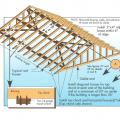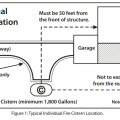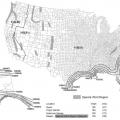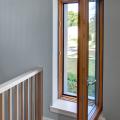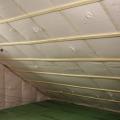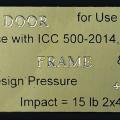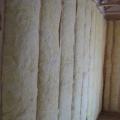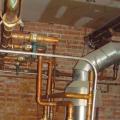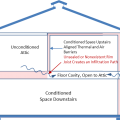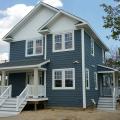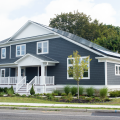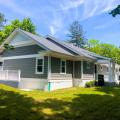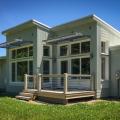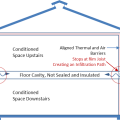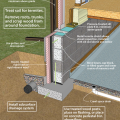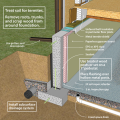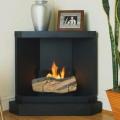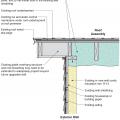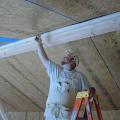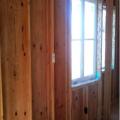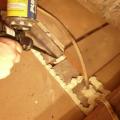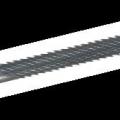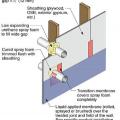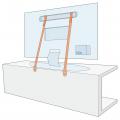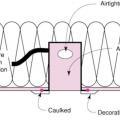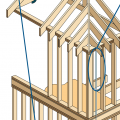Showing results 4151 - 4200 of 4973
Typical installation of plywood openings protection for masonry (including CBS) building.
Typical siting and emergency vehicle turnaround requirements for a private residential cistern for fire protection.
Ultra-efficient, R-9, triple-pane windows have insulated wood frames, argon gas between the panes, and low-emissivity coatings to slow heat transfer.
Underneath the roof sheathing and two exterior layers of rigid foam, the builder stapled netting to the underside of the rafters and filled the roof cavities of the unvented attic with blown-in fiberglass insulation.
Unfaced batt and blown fiberglass wall insulation are installed to RESENET Grade 1 standards with no gaps or voids.
Unfaced fiberglass batt insulation is installed to completely fill the wall cavities and is sliced to fit around wiring, piping, and other obstructions in the wall cavities
Uninsulated, unsealed, or missing rim joists allow attic air and heat into the floor cavity
United Way built this affordable home in the mixed-humid climate in Deer Park, NY, and certified it to DOE Zero energy Ready Home specifications in 2016.
United Way of Long Island built this affordable home in the mixed-humid climate in Coram, NY, and certified it to DOE Zero Energy Ready Home specifications in 2018.
United Way of Long Island built this affordable home in the mixed-humid climate in Deer Park, NY, and certified it to DOE Zero Energy Ready Home specifications in 2015.
United Way of Long Island built this affordable home in the mixed-humid climate in East Patchogue, NY, and certified it to DOE Zero Energy Ready Home specifications in 2019.
United Way of Long Island built this affordable home in the mixed-humid climate in Huntington Station, NY, and certified it to DOE Zero Energy Ready Home specifications in 2017.
United Way of Long Island built this affordable home in the mixed-humid climate in Medford, NY, and certified it to DOE Zero Energy Ready Home specifications in 2021.
United Way of Long Island built this affordable home in the mixed-humid climate in Port Jefferson Station, NY, and certified it to DOE Zero Energy Ready Home specifications in 2020.
Unity Homes built this custom spec home in the cold climate in Walpole, NH, and certified it to DOE Zero Energy Ready Home specifications in 2017.
Unsealed, uninsulated rim joists allow outside air and heat into the floor cavity
Unvented air-sealed crawlspace is insulated along the perimeter walls with rigid foam
Unvented concrete masonry unit crawl space with exterior insulation - designed for termite resistance in moderately infested areas
Unvented crawl space with interior insulation - designed for termite resistance in heavily infested areas
Unvented gas fireplaces release combustion byproducts into the living space, they should not be installed.
Unvented roof assembly at eave retrofitted with rigid foam, spray foam, and a fully adhered membrane seal at the top of wall-to-roof transition
Unvented roof assembly at eave retrofitted with rigid foam, spray foam, and taped top edge of existing house wrap or building paper
Unvented roof assembly at rake retrofitted with a filler piece and taped top edge of existing house wrap or building paper to seal the top of wall-to-roof transition
Unvented roof assembly at rake retrofitted with spray foam installed along the underside of the roof deck and extended to the rake edge to insulate and air seal the attic
Uplift forces acting on the roof are met with roof-wall connections that distribute the forces down the walls and into the foundation along the continuous load path.
Upper-floor tie to lower floor for two-story building. Floor tie anchor and nailed wall sheathing.
Use a smoke pencil to check for air leaks at SIP panel seams, especially along the ridge beam
Use a truss joist header assembly as shown here to reduce thermal bridging in hot climate zones.
Use caulk or spray foam to air-seal all four edges of the blocking material in each joist bay.
Use copper or stainless steel mesh plus caulk or foam around holes in exterior walls or epoxy in cracks in concrete to keep out rodents and termites.
Use corrosion-resistant stainless steel or galvanized steel anchor bolts, tie-downs, and fasteners in coastal and flood-prone locales.
Use flashing tape to seal around any pipes or vents that penetrate through the foam
Use flexible straps to secure large electronics equipment like computer monitors and microwave ovens during seismic events.
Use masking tape as a removable sealer to stop air from leaking around the return grille filter.



